Round-up: 4 folk electro acoustic guitars under £500
Affordable medium-bodied flat-top cutaway electros reviewed
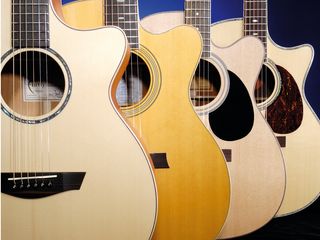
4 folk electros
Despite the fact that Martin, for example, has been making folk-size acoustic guitars for over a century, it’s only in relatively recent years that this kind of medium-bodied flat-top has become a mainstream product for most manufacturers, in particular those in the sub-£500 bracket we’re dealing with here.
Historically, cheaper examples have tended to be sidelined as beginner or young players’ instruments, not to be taken terribly seriously. If, as in this test, you then factor in a cutaway and an electro system, their increasing availability is an even more recent trend. After all, cutaways on acoustics (archtop jazzers excepted) were few and far between until the 1980s, so too dedicated pickup systems, notwithstanding the pioneering work of Ovation and Barcus-Berry during the sixties.
The ‘unplugged’ phenomenon and 'travel' acoustics
So, why the burgeoning choice and increasing popularity of cutaway folk electros? Well, maybe everyone desperately wanted to come up with alternatives to the ubiquitous dreadnought and jumbo. But it’s reasonable to propose that, helped by the late eighties ‘unplugged’ phenomenon and the emergence of so-called ‘travel’ acoustics, people became more aware that smaller-bodied flat-tops could deliver surprisingly robust sounds and, importantly, were far more comfortable to handle than the big-box jobs.
They also tended to be better voiced for fingerstyle. Another persuasive factor not to be overlooked is the development, during the early eighties, of purpose-designed cutaway stage electros, most influentially from Washburn and its Festival Series and Yamaha with its APXs.
Clearly, the industry has gradually recognised that if these, and others, can be a success then there’s no reason why similar adaptations couldn’t be applied to more traditional designs. All our test instruments fall firmly within the folk genre, with bodies between 15-inch and 15.5-inches wide, but there are significant spec variations.
Three of the guitars - the Crafter, Faith and Freshman - have long OM-type scale lengths, while the Recording King’s is a shorter 000-style. The Crafter and Recording King - especially the latter - offer wider fingerstyle necks, while the other two are slimmer and more strum-orientated, with narrower bridge string spacings too.
Preamps are all different: a familiar Fishman Classic 4 on the Recording King; Shadow’s SH863 on the Faith; and tuner-equipped systems on the other two, a Baggs-designed LR-T Pro for the Crafter, and Fishman’s brand new Aero Blend on the Freshman.
The three dearer models boast all-solid-wood construction, though the Crafter’s back and sides are laminated. Surprisingly, China doesn’t wholly rule the roost. The Recording King and Freshman hail from there, but the Crafter is Korean and the Faith is made in Indonesia.
First up: Crafter TMC035 price and specification
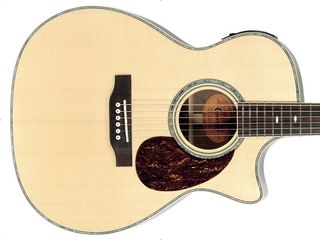
Crafter TMC035 price and specification
Spec
Price: £379
Origin: Korea
Body: Solid Engelmann spruce top, rosewood-veneer back and sides
Neck: Mahogany, 649mm scale, 44.5mm nut
Fingerboard: 21-fret white-bound rosewood
Bridge/spacing: Rosewood/55mm
Electrics: L R Baggs Element under-saddle pickup; LR-T Pro preamp - three-band EQ plus Scoop, phase, tuner
Options: TC035 cutaway electro (£329) with regular headstock
Finish: Gloss natural body, satin neck
Next: Crafter TMC035 build and features
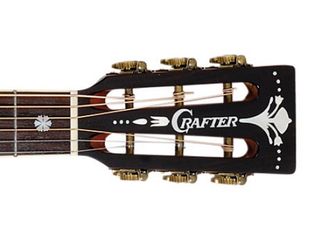
Crafter TMC035 build and features
Build and features
This recently introduced model is a slot-head version of Crafter’s TC035, apparently one of the company’s best sellers. The rosewood-faced Spanish peghead lends an attractive retro air, emphasised by aged-brass open- back tuners and the fingerboard’s diamond/cat’s-eye markers.
The good-looking solid Engelmann spruce top receives a deluxe treatment of pearl purfling and a similarly inlaid rosette. The back and sides aren’t truly laminated rosewood, as the innermost veneer is mahogany or similar. It’s anybody’s guess what constitutes the in-between ply.
Still, the guitar is smartly turned out. The satin neck, with its moderate-depth ‘C’ profile, is a fine player. The semi-wide 44.5mm nut span offers easy fingerstyle, yet feels sufficiently snug for general chord work. Fretting and set-up are excellent, allowing a slinky, fast action.
Next: Crafter TMC035 sounds, pros and cons
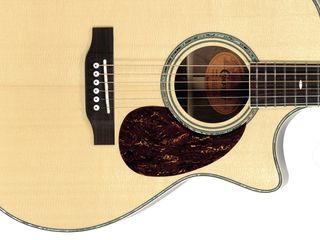
Crafter TMC035 sounds, pros and cons
Sounds
The TMC035 proves a very pleasant, open-voiced performer, with supple dynamics and a sparkling yet warmishly underpinned tone.
The gain- packed LRT-Pro system proves a sympathetic powered partner, and our sample’s inter-string output balance is refreshingly spot-on.
The Scoop slider, dipping up to -6dB at 1kHz, is a particularly useful adjunct to the main 500Hz EQ slider for reining back unwanted mids, while the treble and bass bands are efficient at tempering the instrument’s brightish timbre when required and fleshing out the low-end respectively.
The auto-chromatic tuner works accurately, and the ‘OK’ legend denoting in-tune status is a matey touch.
Pros: Deluxe, retro looks; open, supple sounds.
Cons: Lack of strap button at the heel.
4.5 out of 5
Verdict: An easy player with fingerstyle appeal.
Next: Recording King ROC-36CFE price and specification
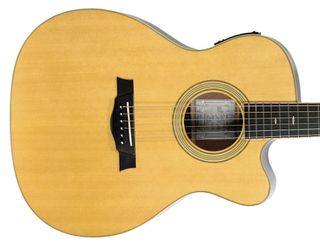
Recording King ROC-36CFE price and specification
Spec
Price: £429
Origin: China
Body: Solid Sitka spruce top, solid mahogany back and sides
Neck: Mahogany, 630mm scale, 44.5mm nut
Fingerboard: 20-fret maple-bound ebony
Bridge/spacing: Ebony/57.5mm
Electrics: Fishman Matrix under-saddle pickup, Classic 4 preamp with four-band EQ
Options: ROC-37CFE (£539) with solid rosewood back and sides
Finish: Gloss natural
Next: Recording King ROC-36CFE build and features
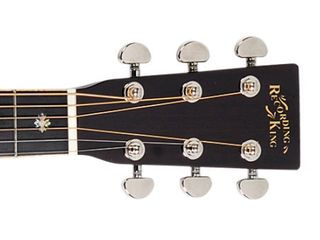
Recording King ROC-36CFE build and features
Build and features
This Contemporary Series 000 has fewer vintage appointments than its Classic Series counterparts, but there’s still a distinctly heritage vibe about the instrument due to its spade headstock, diamond volute under the nut, amber-tint top and early Style 45-redolent ’board markers.
The all-over gloss lacquering also has a kind of ‘old’ feel to it, added to which is the body and neck’s maple binding. The guitar’s all- solid, spruce/mahogany build is affirmed by the internal rim reinforcing strips, and the ebony fingerboard and bridge are quality touches.
Most vintage-like is the uncompromisingly fingerstyle neck (which, incidentally, is one- piece – unusual at this price). It’s no wider than the Crafter’s at the nut, but broadens to a substantial 57mm come the octave, with a similar bridge string spacing.
This will certainly deter smaller- handed players, but for airy, accurate picking it’s a beauty, and the neck is kept shallow to avoid undue bulk.
Next: Recording King ROC-36CFE sounds, pros and cons
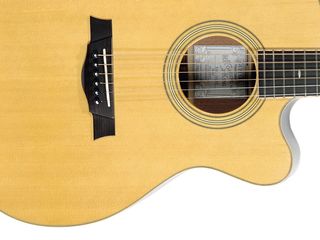
Recording King ROC-36CFE sounds, pros and cons
Sounds
Though sustainful, the main impression is a taut, even vaguely tight, feel and delivery, but if you dig in the guitar responds with a decent attack and projection. The tone is brightish, but well integrated.
The Classic 4 is capable of plenty of powered warmth, but it’s inhibited here by a very dominant low E output, which necessitates the bass slider being trimmed back in compensation.
Treble and brilliance need fairly modest settings to avoid the high-end becoming too papery, but cure that under-saddle imbalance and the system would become predictably surefooted.
Pros: Fingerstyle-dedicated neck, if you cope with the span.
Cons: Poor under-saddle output balance.
4 out of 5
Verdict: The clear choice for purist fingerpickers.
Next: Faith FV Venus price and specification
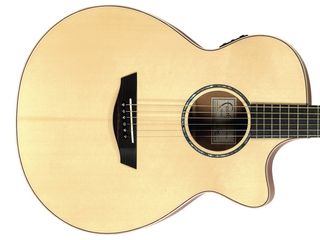
Faith FV Venus price and specification
Spec
Price: £499 (inc case)
Origin: Indonesia
Body: Solid Engelmann spruce top, solid mahogany back and sides
Neck: Mahogany, 645mm scale, 43mm nut
Fingerboard: 20-fret black-bound macassar ebony
Bridge/spacing: Macassar ebony/53mm
Electrics: Shadow Nanoflex under-saddle pickup; SH863 preamp with two-band EQ; EQ shape and phase
Options: FV Hi-Gloss (£579), FEV Eclipse (£439) in black with laminated back/sides
Finish: Gloss top, satin back, sides and neck
Next: Faith FV Venus build and features
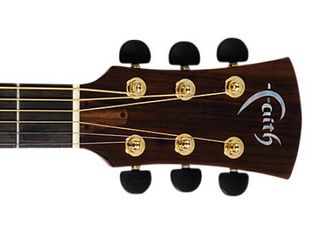
Faith FV Venus build and features
Build and features
Compared with the more Martin- like styling of the other guitars, this curvier-profiled Natural Series Faith resembles a scaled- down mini-jumbo and, aptly perhaps, has the deepest rims on test.
Originally the model, save for the gloss headstock overlay, was totally satin-finish, but now features a gloss top, which nicely lifts the whole ambience. Build quality and detailing are impressively clean and precise; the all-solid spruce/mahogany body is bound with maple, while the bridge, fingerboard and tuner buttons are all ebony.
Kicking off at 43mm, the neck is a pretty slim affair, with only modest broadening further up and slightly tight string spacing at the bridge. However, it’s an easy, slick general-purpose player and the medium-depth ‘C’-cum-’D’ profile neck cups very obligingly in the hand.
Next: Faith FV Venus sounds, pros and cons
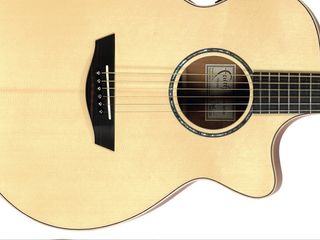
Faith FV Venus sounds, pros and cons
Sounds
Acoustically the sound is not dissimilar to that of the Crafter, sharing a mildly scooped tonality and sense of sweet-edged openness that’s easy on the ear.
Volume and dynamics are roughly the same, too. Earlier- generation Shadow systems could be coruscatingly bright, but the SH863, partnered by a Nanoflex under-saddle pickup, is much more refined, with sparkling rather than strident highs and a generous low-end range.
Two-band EQ seems a tad mean, but the instant smile- curve ‘scoop’ switch compensates well for the absence of a dedicated mid-range. Most of the volume control’s gain comes near maximum, which may or may not bother you, but the controls’ recessable knobs are a nice touch.
Pros: Clean build; sprightly sweet-toned sounds.
Cons: Nothing of note.
4.5 out of 5
Verdict: Faith, as usual, comes up with the well-priced quality goods.
Next: Freshman FA350GACE price and specification
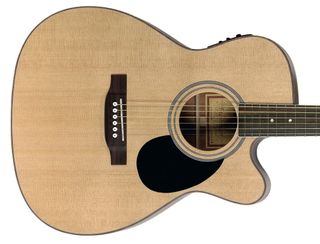
Freshman FA350GACE price and specification
Spec
Price: £499
Origin: China
Body: Solid Sitka spruce top, solid mahogany back and sides
Neck: Mahogany, 650mm scale, 43mm nut
Fingerboard: 20-fret white-bound rosewood
Bridge/spacing: Rosewood/51mm
Electrics: Fishman Aero Blend piezo/mic system with three-band EQ, notch, phase, mic blender, tuner
Options: Folk-body FA350FCES (£529) with Schertler BlueStick system
Finish: Satin natural
Next: Freshman FA350GACE build and features
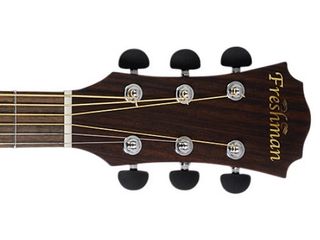
Freshman FA350GACE build and features
Build and features
This recently launched model is described as a grand auditorium, but it’s actually auditorium in size. It also happens to be one of the first instruments in the world to carry Fishman’s new Aero Blend system that, like equivalent Prefix blenders, has its mic on the inward face of the preamp.
The guitar’s all-solid spruce/ mahogany construction is immaculately satin finished, the body carrying classy-looking coach-lined mahogany binding. The average-width neck, which like the Faith has a second strap button at the heel, is the shallowest on test, the flattish- back profile providing a very snug grip.
Regrettably, however, string spacing at the bridge is overly snug, at a measly 51mm. Fingerstyle is possible, of course, but will feel decidedly cramped to dedicated pickers.
Next: Freshman FA350GACE sounds, pros and cons
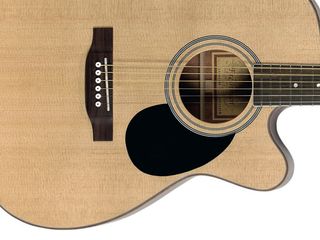
Freshman FA350GACE sounds, pros and cons
Sounds
Though not having especially capacious rims, the guitar excels for bottom-end clout, with abundant woody warmth for quite muscular projection if not great sweetness.
The Aero enjoys working with this, delivering some rewardingly rich sounds depending on how you juggle the three-band EQ, phase reverse and, if necessary, notch filter.
Mic gain can be varied via an internal trimpot, and it’s set fairly modestly here – a good thing because, as always with such systems, a little blending goes a long way before undesirably swishy ambience rears its head.
Irritations? The knobs are small and fiddly except for the volume control. Bonus? The auto- chromatic tuner’s bright, fast- acting, circular LED display makes tuning tweaks a doddle.
Pros: Beefy low-end response; rich powered sounds.
Cons: Tight string spacing at bridge; tiny preamp knobs.
4 out of 5
Verdict: Strummers will find plenty to enjoy.
Next: The verdict - which folk electro is best?

The Verdict
Verdict
With Far East manufacturing fine-tuned to a sophisticated degree these days, we’ve all come to expect high standards at ever- more affordable prices. Pleasing to report then, that if £500 is your ceiling for a folksome cutaway electro, these four guitars acquit themselves extremely well for overall quality and value, and all are worthy of serious consideration: indeed in general terms it’s quite hard to select one which is head and shoulders above the rest.
As is often the case, it boils down to horses for courses. If fingerpicking is your favoured thing, the Crafter and Recording King are the prime candidates, though you’ll need to be a latter because the broad neck doesn’t really take prisoners. Hats off to them, though, because aside from other Recording King 000s there are no other budget folks around so unequivocally catering for this playing style.
That said, the Crafter does offer a much gentler introduction to the wider format, with a neck that remains comfortable for general playing. In theory it loses marks for not using all-solid woods, but that’s offset by its lower price and it is also one of the nicest-sounding guitars on test. And it’s a good looker too.
One minor practical point where both the Crafter and Recording King could be improved is having a strap button at the heel, as the Faith and obligatory on cutaway electros and would add mere pence to the manufacturing cost.
Strummers will head for the Faith or Freshman, whose price tags generously include a case. By a short head we’d favour the Faith, not just for its supple, open-toned voicing but the fact that its neck, while slim, has string spacing that is still viable for comfortable, occasional fingerstyle forays.
Sad to say the Freshman, with that even tighter spacing at the bridge, is really a strummer only, and the company should seriously consider widening the span because in all other respects it’s a fine guitar with a strong, bass-rich acoustic sound and a very versatile new preamp.
----------------------------------------------------------------------------------------------------------------------------------------------------------------
Liked this? Now read: 4 nylon-string electro acoustic guitars
Connect with MusicRadar: via Twitter, Facebook and YouTube
Get MusicRadar straight to your inbox: Sign up for the free weekly newsletter










